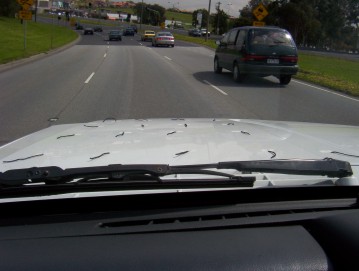
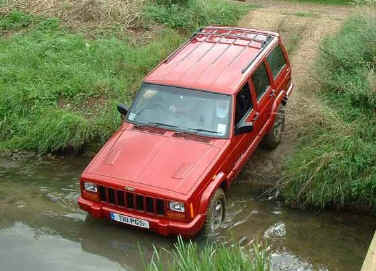
Bonnet/Hood Vents
As our engine bays are so crowded, a lot of the over heating we suffer is because the air cannot leave faster enough. This problem is at it's worse at four wheeling speeds as there is no ram effect from travelling fast to help vent the hot air out. The problem get even worse the more that is added under the bonnet area like dual batteries, air compressors etc. Removing the rubber from under the sump, if it is still there, will help some but otherwise you should use a cowl bonnet or vents in it. It is just like the engine, if you have restrictive exhaust, it does not matter how free you intake side is, it cant flow more then you can exit out the exhaust. You have to see the exhaust as the under bonnet area, the radiator as the engine and the air flow from speed, or the fans drawing the air through it, as the intake. So here is a few ideas below of others that have come up with solutions to this problem.
I did some aero tests to see what would be the best place to put them. By sticking strips of wool on the bonnet and then going for a drive I found that the first half of the bonnet has a negative pressure area as I had surmised. If you look closely you will see the wool at the front being pulled forward and even straight up. But as the speed increased to around 40 - 50 mph, the wool was pulled around and kept flat like the rest of the bonnet indicating that the air stream was being forced flat at the higher speed. You can really get bogged down when you start to take into account things like Laminar flow, Random turbulent flow, Bernoulli's equation and Reynolds numbers etc. Basically having them in the front 1/3 will make it better at speed ( why Rally cars have them there ), and putting them in the rear 1/3 is better suited to slow 4wd speeds.
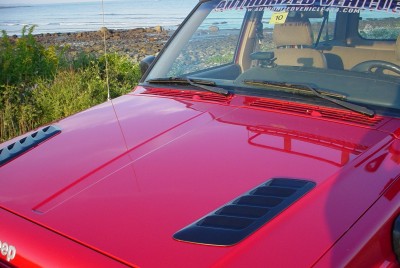
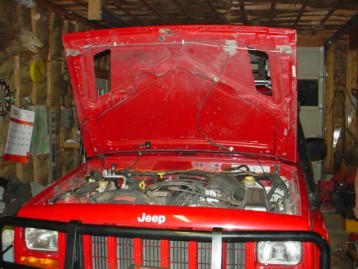
Above is Tozovr's XJ who has fitted Pontiac Grand Prix vents. These are far cheaper than the ZJ ones. They work better without their drip pans but it is one way to have control over where the water goes that comes through the vents. From tests I have seen you can expect between 15 to 25*F lowering of under hood temperature depending on speed at the time.
Part Numbers and Costs at the time for
these vents:
#10225885 - Left Side Louver $28.95. #10230097- Left Side Drip Pan $8.00
#10225886 - Right Side Louver $28.95. #10230098 - Right Side Drip Pan $8.00
You can pick them up at a Pontiac dealer or online at: http://www.parts.com/index.cfm?action=goToStoreFront&sfid=192
Also try this place for a range of vents for you guys in the USA: http://www.genright.com/category.aspx?categoryID=117
Here is Jeepzz's with original ZJ ones fitted to his hood and also some vents on the next one that came off a Nissan 260Z coupe. These have been added more towards the rear which is the safest position due to the points already mentioned. You can see a full install of adding these vents here.
These vents are on Markus Kamer's Xj which he bought off me. Normally on a 100 series Landcruiser sitting on at the rear most pillar ( D pillar ) as an exit vent for internal cabin pressure. They are very neat looking.
Don from Arab, Alabama has fitted the ZJ factory vents toward the rear of the bonnet in the best location for cooling at low speeds. He has also managed to include the factory drip trays underneath as well. The trays can be removed and replaced easily depending on the seasons and cooling requirements.
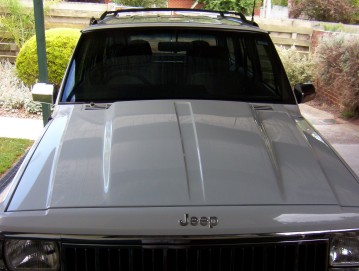
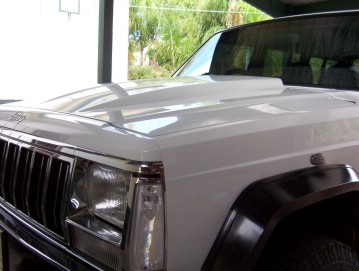
But I ended up with going the above route and fitting an all steel replacement induction hood as it was easier to keep water and dust out as the rear vent is vertical. At low speeds the hot air was venting directly from under the bonnet and up the screen but as the speed rose it drew cold air in. You are looking at a 70*F drop in under temperatures with this sort of setup. See my write up on the above bonnet here. I have my air intake picking up from the rear vent too and have a temperature probe there which shows it is drawing air at speed the same as outside temperature. That is a big drop from the very heated intake point where it sucks heated air radiated from the headers and engine etc.
[Index]